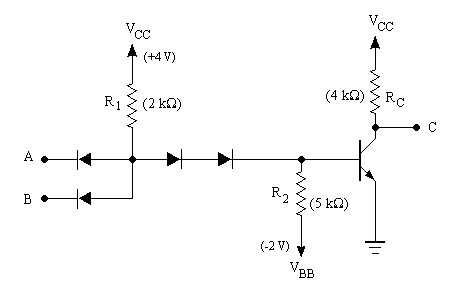I 've implemented this basic logic gate on a breadboard. Only my circuit has +5 supply voltage. The resistor values are 10K for diode inputs and 1K for collector of the transistor. The transistor is a 2N3904 and the diodes are 1N4148.
Here's a pic:

I'm really confused about the inputs for this. I've read that the inputs should be low voltage, but I've tried all sorts of voltages and nothing. However, when I put one of the inputs to ground, the LED turns on. This got me thinking, if in fact connecting input to ground was 1, then both of them being to ground "AND" would cause the LED to shut off. If thats the case, how on earth do I implement this with a button or switch? Also, is my circuit shorting somehow, or perhaps are these values not working with the +5V? I've tested the RTL version and the 1K + 10K + 2N3904 works perfectly.

(source: jones at people.seas.harvard.edu)
